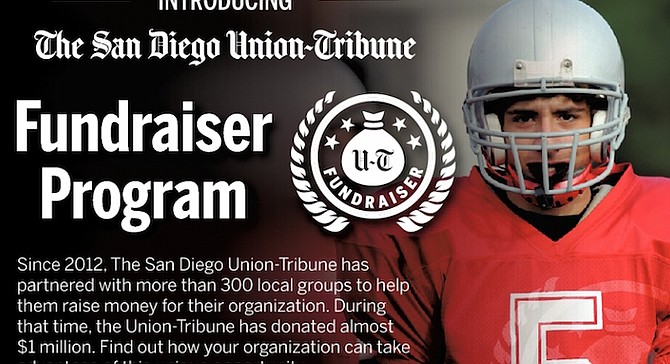 Facebook
Facebook
 X
X
 Instagram
Instagram
 TikTok
TikTok
 Youtube
Youtube

The Union-Tribune has a new gimmick to boost circulation -- possibly losing money in the process. The paper is advertising that you can get a one-year Sunday subscription plus all-digital access for a mere $4.68 and your favorite charity will get $10 for each subscription it sells.
In a U-T ad, two nonprofits rave about this amazing deal. They raised oodles of money getting the Sunday paper so cheap plus $10 for each subscriber they signed up.
I called the U-T's circulation department and asked what it would cost me to get a year of Sunday papers plus digital access. The price: $181.48. Repeat: $181.48.
This is not the first time the U-T has used charitable organizations to boost circulation. Back in 2013, the U-T was selling papers for a penny apiece to groups such as churches. The nonprofits would turn around and sell the paper at a standard price -- say, a dollar or two or three -- to congregants and pocket the difference. It was advantageous to the U-T because the Alliance for Audited Media, which purports to measure newspaper circulation, counts a paper sold for a penny as paid circulation.
Circulation per se often doesn't make money for newspapers. It's the ads that bring in the bucks. But if circulation rises, ad prices go up. Trouble is, with gimmicks like this, advertisers may conclude that the circulation numbers are artificially pumped up.


The Union-Tribune has a new gimmick to boost circulation -- possibly losing money in the process. The paper is advertising that you can get a one-year Sunday subscription plus all-digital access for a mere $4.68 and your favorite charity will get $10 for each subscription it sells.
In a U-T ad, two nonprofits rave about this amazing deal. They raised oodles of money getting the Sunday paper so cheap plus $10 for each subscriber they signed up.
I called the U-T's circulation department and asked what it would cost me to get a year of Sunday papers plus digital access. The price: $181.48. Repeat: $181.48.
This is not the first time the U-T has used charitable organizations to boost circulation. Back in 2013, the U-T was selling papers for a penny apiece to groups such as churches. The nonprofits would turn around and sell the paper at a standard price -- say, a dollar or two or three -- to congregants and pocket the difference. It was advantageous to the U-T because the Alliance for Audited Media, which purports to measure newspaper circulation, counts a paper sold for a penny as paid circulation.
Circulation per se often doesn't make money for newspapers. It's the ads that bring in the bucks. But if circulation rises, ad prices go up. Trouble is, with gimmicks like this, advertisers may conclude that the circulation numbers are artificially pumped up.
Comments